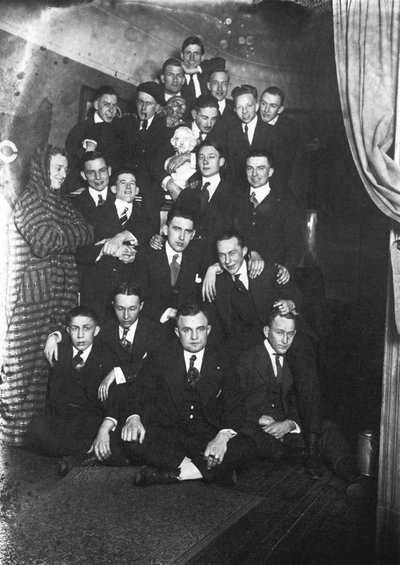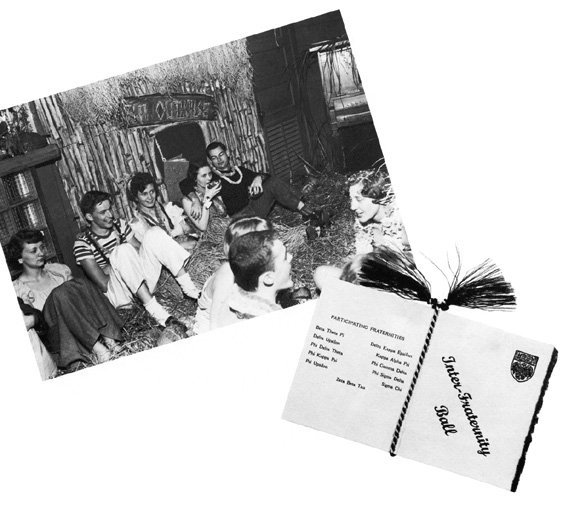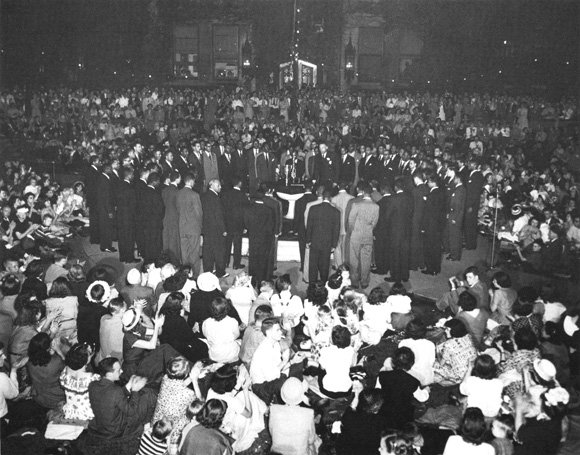The Social Scene

In the company of a skull and a cigarette-puffing bust of Shakespeare, the brothers of Sigma Nu posed for this informal portrait. Mostly undergraduate in membership, Sigma Nu also admitted a few graduate students.
Fraternities
The place of fraternities at the University of Chicago was clearly on President Harper's mind as he prepared busily for opening day in 1892. At the first faculty meeting, he presented a proposal for limiting their influence. His position was defined in a speech later published under the title "The Antagonism of Fraternities to the Democratic Spirit of Scholarship," where Harper declared, "I for one am a firm believer in the old-fashioned literary society."
Harper had little regard for what he believed to be essentially non-academic, secret societies; but, since few members of the faculty and administration were eager to terminate fraternities altogether, the University chose instead to sanction them under the auspices of the housing office.
The number of fraternities rose in the following years as they gained autonomy from the University housing system. By 1928 the Greek system had reached its peak with 751 members and thirty-three chapters dotting the campus surroundings. The fraternities' strength in numbers and their access to important social positions made them a leading influence in campus social life.
Since Greek organizations
were by their very nature selective and exclusive, not all students
benefited from this development. Jewish students, for instance, had
difficulty gaining membership info any fraternity other than the predominantly
Jewish houses. African-American students, who encountered similar difficulties,
formed the all-black Kappa Alpha Psi fraternity, only to be barred from
the Interfraternity Council on the dubious grounds that they did not
have their own house.
By the early 1940s fraternity membership had declined sharply to just ten chapters and 250 pledges. On November 15, 1945, the Hutchins administration in conjunction with the Board of Trustees, after determining that fraternities would "tend to conflict" with the success of the new four-year college, weakened the Greek system further by announcing that fraternity membership would not be permitted for first-and second-year students in the new four-year college, since most of these students would be of high school age.
Third- and fourth-year men, of course, were still able to participate in the fraternity system. But with membership limited to two years instead of the previous four, the stature of the Greek system was diminished.
A steady decline in student interest throughout the 1960s and 1970s reduced the Greek system to a handful of chapters, but these led the fight in their national organizations to remove all discriminatory barriers. During the 1980s, fraternities once again became a focus of interest and remain a lively, if relatively modest, feature of campus life.

Despite the disruptions in campus life brought by World War II and its aftermath, the Interfraternity Ball remained the highlight of the social calendar.

Held in Hutchinson Court and routinely drawing between three and five thousand observers, the annual spring Interfraternity Sing was one of the most popular campus events. Members of Kappa Alpha Psi fraternity are seen performing here. Photograph by Stephen Lewellyn (AB 1948).
